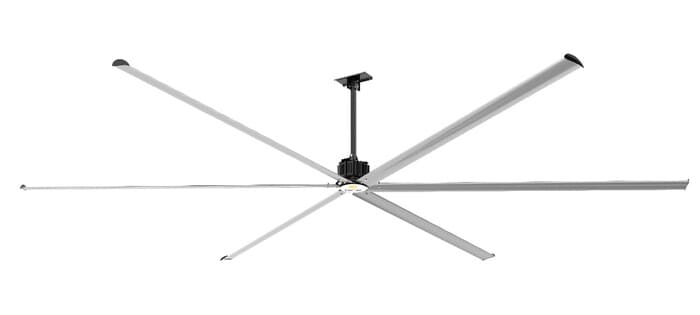1. What is CFM? Why is it important?
CFM (Cubic Feet per Minute) refers to the volume of air that a fan can move per minute. It determines the efficiency of air circulation, affecting the cooling effect, air quality and overall comfort. For HVLS Ceiling Fan, higher CFM means greater airflow coverage, which can move a large amount of air more efficiently, thereby achieving air circulation in a large space.
Factors that affect CFM
Fan diameter: Larger fans generally cover a larger area and produce higher CFM values.
Speed (RPM): HVLS fans generally have lower RPMs, but still produce adequate air volume due to their larger blades.
Blade design: High-quality aerodynamic blades can increase air volume output while reducing energy consumption.
2. How to calculate CFM and space size
To ensure that you have selected the right HVLS Ceiling Fan, you need to calculate the required CFM based on the volume of the space. Generally, the selection of CFM takes into account the room volume (cubic feet) and the number of air changes per hour (ACH).
Calculation formula
Space volume (cubic feet) = length (ft) × width (ft) × height (ft)
Air changes (ACH) = target air replacement rate (usually determined by the usage scenario, see the table below)
60 = 60 minutes per hour (convert ACH to CFM)
Recommended ventilation times (ACH) for different scenarios
Space Type
|
Recommended ACH Value
|
Warehouse
|
2 - 6
|
Production workshop
|
6 - 12 |
Gym
|
8 - 12 |
Shopping center
|
4 - 8 |
Cold Storage
|
10 -20 |
Gym
|
6 - 10 |
Example Calculation
Assume you have a 100ft × 80ft × 25ft warehouse and want to achieve an air change rate of 3 times per hour (ACH = 3).
Calculate the volume of the space:
[100 × 80 × 25 = 200,000 text{ cubic feet}]
Calculate the required CFM:
[frac{200,000 × 3}{60} = 10,000 text{ CFM}]
This means that to ensure proper air circulation, you will need at least an HVLS ceiling fan that provides 10,000 CFM. If the space is larger, you may need multiple fans or a larger fan.
3. How to select HVLS Ceiling Fan based on CFM?
HVLS Ceiling Fans of different sizes have different CFM outputs. Here is the approximate size vs. CFM relationship:
Fan diameter (ft)
|
Typical CFM Range
|
8-10 ft
|
10,000 - 20,000
|
12-14 ft
|
20,000 - 40,000
|
16-18 ft
|
40,000 - 70,000
|
20-24 ft
|
70,000 - 120,000
|
When selecting a fan, make sure the CFM of the model you choose is equal to or higher than the calculated demand value to ensure effective air flow in the space.
4. Other purchase considerations
1. Number and layout of fans
If the CFM of a single fan is not enough to cover the entire area, multiple HVLS fans can be installed and their airflow distribution can be even. For example, in a very large warehouse, multiple fans are usually distributed in a grid pattern to ensure that there are no dead spots in the air circulation.
2. Fan installation height
It is recommended to install at a height of 18-25 feet to ensure the best wind effect.
Below 15 feet may cause the airflow to be too concentrated, affecting comfort.
Below 30 feet may reduce the ground airflow speed and affect the cooling effect.
3. Energy efficiency and variable frequency control
Choosing HVLS fans with variable frequency drives (VFDs) can adjust wind speed according to actual needs, improve energy efficiency, and reduce operating costs.
Energy-saving motors and optimized fan blade designs can also improve fan efficiency and reduce energy consumption.
If you are looking for a suitable HVLS fan, you may wish to use the above calculation method to find the model that best suits you.
If you have any questions or need professional advice, please contact us and we will provide you with the best HVLS Ceiling Fan purchasing solution!
